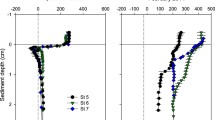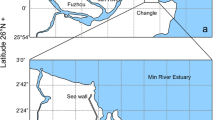Abstract
Shallow marine bioturbation plays a crucial role in enhancing pore-water ventilation, oxygen and nutrition cycling, and ecosystem productivity. In this study, it was found that a thin layer of sandstone in the uppermost part of the Late Cretaceous Zallum Formation from northern Saudi Arabia had been moderately bioturbated. The bioturbated sediments were consolidated through the cementation of remarkably preserved biological matter, resulting in the formation of a rod-shaped morphology. These rod-shaped bioturbated sediments were assembled, forming a distinctive network-like structure that enables them to be readily distinguished from the surrounding unconsolidated host sediments. Geochemical analysis revealed a notable pattern of iron enrichment in the biological matter, bioturbated sediments, and host sediments. The biological matter has a substantial total iron concentration, with a significant proportion of Fe(II). In contrast, the host sediments have a high iron enrichment factor, but a comparatively lower total iron content and proportion of Fe(II). Conventionally, bioturbation often leads to an increase in the iron content by promoting the fixation of iron in the form of Fe(III). Contrary to the conventional understanding, the results of this study suggest that the microenvironment established by the biological matter within the burrows actually accelerated the removal of iron from the burrowed sediments in the form of Fe(II) ions. The release of iron from the burrowed sediments could have implications for the supply of iron nutrients in the overlying water. As a result, this study provides further insights into the impact on primary productivity in a bioturbated shallow marine environment.








Similar content being viewed by others
Data availability
The authors declare that the data supporting the findings of this study are available within the paper and its Supplementary Information files.
References
Bar O, Zilberman E, Feinstein S, Calvo R, Gvirtzman Z (2016) The uplift history of the Arabian Plateau as inferred from geomorphologic analysis of its northwestern edge. Tectonophysics 671:9–23. https://doi.org/10.1016/j.tecto.2016.01.004
Beam JP, Scott JJ, McAllister SM, Chan CS, McManus J, Meysman FJR, Emerson D (2018) Biological rejuvenation of iron oxides in bioturbated marine sediments. ISME J 12:1389–1394. https://doi.org/10.1038/s41396-017-0032-6
Beauvois A, Vantelon D, Jestin J, Bouhnik-Le Coz M, Catrouillet C, Briois V, Bizien T, Davranche M (2021) How crucial is the impact of calcium on the reactivity of iron-organic matter aggregates? Insights from arsenic. J Hazard Mater 404:124127. https://doi.org/10.1016/j.jhazmat.2020.124127
Boyd PW, Ellwood MJ (2010) The biogeochemical cycle of iron in the ocean. Nat Geosci 3:675–682. https://doi.org/10.1038/ngeo964
Boyle RA, Dahl TW, Dale AW, Shields-Zhou GA, Zhu M, Brasier MD, Canfield DE, Lenton TM (2014) Stabilization of the coupled oxygen and phosphorus cycles by the evolution of bioturbation. Nat Geosci 7:671–676. https://doi.org/10.1038/ngeo2213
Canfield DE (1989) Reactive iron in marine sediments. Geochim Cosmochim Acta 53:619–632. https://doi.org/10.1016/0016-7037(89)90005-7
Capone DG, Hutchins DA (2013) Microbial biogeochemistry of coastal upwelling regimes in a changing ocean. Nat Geosci 6:711–717. https://doi.org/10.1038/ngeo1916
Cribb AT, Bottjer DJ (2020) Complex marine bioturbation ecosystem engineering behaviors persisted in the wake of the end-Permian mass extinction. Sci Rep 10:203. https://doi.org/10.1038/s41598-019-56740-0
Davenport ES, Shull DH, Devol AH (2012) Roles of sorption and tube-dwelling benthos in the cycling of phosphorus in Bering Sea sediments. Deep Sea Res Part II 65–70:163–172. https://doi.org/10.1016/j.dsr2.2012.02.004
Defforey D, Paytan A (2018) Phosphorus cycling in marine sediments: advances and challenges. Chem Geol 477:1–11. https://doi.org/10.1016/j.chemgeo.2017.12.002
Farouk S, Marzouk AM, Ahmad F (2014) The Cretaceous/Paleogene boundary in Jordan. J Asian Earth Sci 94:113–125. https://doi.org/10.1016/j.jseaes.2014.08.015
Gledhill M, Buck K (2012) The organic complexation of iron in the marine environment: a review. Front Microbiol. https://doi.org/10.3389/fmicb.2012.00069
Guénet H, Davranche M, Vantelon D, Gigault J, Prévost S, Taché O, Jaksch S, Pédrot M, Dorcet V, Boutier A, Jestin J (2017) Characterization of iron–organic matter nano-aggregate networks through a combination of SAXS/SANS and XAS analyses: impact on As binding. Environ Sci Nano 4:938–954. https://doi.org/10.1039/C6EN00589F
He Y, Wu H, Ke S, Liu S-A, Wang Q (2017) Iron isotopic compositions of adakitic and non-adakitic granitic magmas: magma compositional control and subtle residual garnet effect. Geochim Cosmochim Acta 203:89–102. https://doi.org/10.1016/j.gca.2017.01.005
Ivleva NP, Wagner M, Horn H, Niessner R, Haisch C (2009) Towards a nondestructive chemical characterization of biofilm matrix by Raman microscopy. Anal Bioanal Chem 393:197–206. https://doi.org/10.1007/s00216-008-2470-5
Jégou D, Schrader S, Diestel H, Cluzeau D (2001) Morphological, physical and biochemical characteristics of burrow walls formed by earthworms. Appl Soil Ecol 17:165–174. https://doi.org/10.1016/S0929-1393(00)00136-0
Keene AF, Johnston SG, Bush RT, Burton ED, Sullivan LA, Dundon M, McElnea AE, Smith CD, Ahern CR, Powell B (2014) Enrichment and heterogeneity of trace elements at the redox-interface of Fe-rich intertidal sediments. Chem Geol 383:1–12. https://doi.org/10.1016/j.chemgeo.2014.06.003
Li B, Feng M, Chen X, Wang Y, Shen Y, Wu QL (2021) Abundant sediment organic matter potentially facilitates chemical iron reduction and surface water blackness in a Chinese deep lake. Environ Pollut 272:116002. https://doi.org/10.1016/j.envpol.2020.116002
Liu Y, Zhang Y, Lan S, Hou S (2019) Migration experiment and numerical simulation of modified nanoscale zero-valent iron (nZVI) in porous media. J Hydrol 579:124193. https://doi.org/10.1016/j.jhydrol.2019.124193
Lohrer AM, Thrush SF, Gibbs MM (2004) Bioturbators enhance ecosystem function through complex biogeochemical interactions. Nature 431:1092–1095. https://doi.org/10.1038/nature03042
Martin JH, Fitzwater SE (1988) Iron deficiency limits phytoplankton growth in the north-east Pacific subarctic. Nature 331:341–343. https://doi.org/10.1038/331341a0
Meysman FJR (2014) Oxygen burrowed away. Nat Geosci 7:620–621. https://doi.org/10.1038/ngeo2218
Moore CM, Mills MM, Arrigo KR, Berman-Frank I, Bopp L, Boyd PW, Galbraith ED, Geider RJ, Guieu C, Jaccard SL, Jickells TD, La Roche J, Lenton TM, Mahowald NM, Marañón E, Marinov I, Moore JK, Nakatsuka T, Oschlies A, Saito MA, Thingstad TF, Tsuda A, Ulloa O (2013) Processes and patterns of oceanic nutrient limitation. Nat Geosci 6:701–710. https://doi.org/10.1038/ngeo1765
Raiswell R, Canfield DE (2012) The iron biogeochemical cycle past and present. Geochim Perspect 1:1–220
Rooze J, Meile C (2016) The effect of redox conditions and bioirrigation on nitrogen isotope fractionation in marine sediments. Geochim Cosmochim Acta 184:227–239. https://doi.org/10.1016/j.gca.2016.04.040
Rubin M, Berman-Frank I, Shaked Y (2011) Dust- and mineral-iron utilization by the marine dinitrogen-fixer Trichodesmium. Nat Geosci 4:529–534. https://doi.org/10.1038/ngeo1181
Scholz F, McManus J, Mix AC, Hensen C, Schneider RR (2014) The impact of ocean deoxygenation on iron release from continental margin sediments. Nat Geosci 7:433–437. https://doi.org/10.1038/ngeo2162
Strzepek RF, Maldonado MT, Hunter KA, Frew RD, Boyd PW (2011) Adaptive strategies by Southern Ocean phytoplankton to lessen iron limitation: uptake of organically complexed iron and reduced cellular iron requirements. Limnol Oceanogr 56:1983–2002. https://doi.org/10.4319/lo.2011.56.6.1983
Tagliabue A, Bowie AR, Boyd PW, Buck KN, Johnson KS, Saito MA (2017) The integral role of iron in ocean biogeochemistry. Nature 543:51–59. https://doi.org/10.1038/nature21058
Tagliabue A, Bowie AR, DeVries T, Ellwood MJ, Landing WM, Milne A, Ohnemus DC, Twining BS, Boyd PW (2019) The interplay between regeneration and scavenging fluxes drives ocean iron cycling. Nat Commun 10:4960. https://doi.org/10.1038/s41467-019-12775-5
Taylor AM, Goldring R (1993) Description and analysis of bioturbation and ichnofabric. J Geol Soc 150:141–148. https://doi.org/10.1144/gsjgs.150.1.0141
Tribovillard N, Algeo TJ, Baudin F, Riboulleau A (2012) Analysis of marine environmental conditions based onmolybdenum–uranium covariation—Applications to Mesozoic paleoceanography. Chem Geol 324–325:46–58. https://doi.org/10.1016/j.chemgeo.2011.09.009
Vandenbroucke M, Largeau C (2007) Kerogen origin, evolution and structure. Org Geochem 38:719–833. https://doi.org/10.1016/j.orggeochem.2007.01.001
Vantelon D, Davranche M, Marsac R, La Fontaine C, Guénet H, Jestin J, Campaore G, Beauvois A, Briois V (2019) Iron speciation in iron–organic matter nanoaggregates: a kinetic approach coupling Quick-EXAFS and MCR-ALS chemometrics. Environ Sci Nano 6:2641–2651. https://doi.org/10.1039/C9EN00210C
Yin M, Li JX (2011) Analysis of Rock and Minerals. Geological Publishing House, Beijing
Zhang W, Li X, Zhou J (2018) Effect of different colloids on Fe migration in saturated porous media under variable hydochemical and hydrodynamic conditions. American Geophysical Union Fall meeting. American Geophysical Union
Zhang Y, Li Z, Qin M, Bao Z, Li Z, Yi L, Li G (2021) Sedimentology and stratigraphy sequence of the north of Saudi Arabia: implications for the evolution of the Neo-Tethys in the Late Cretaceous. Geol J 56:1510–1530. https://doi.org/10.1002/gj.4013
Acknowledgements
The research was supported by the National Natural Science Foundation for Young Scientists of China (Grant No. 42102086). Funding for the sample collection was provided by the Beijing Research Institute of Uranium Geology (BRIUG). We would like to thank Yang Li, Ahmed Banakhar, and Abdullah M. Shammari for their assistance in the field. The laboratory analysis was supported by Apeng Yu, Ting Li, Linfei Qiu, Ruiping Liu, Zongyao Tai, Liumin Deng, Xiangkun Ge, and Yongzhi He, all of whom are affiliated with the Analytical Laboratory of BRIUG. We express our gratitude to Chengyu Yang of the China University of Petroleum (Beijing) for performing the dichloromethane extraction and chromatographic analysis.
Author information
Authors and Affiliations
Corresponding authors
Ethics declarations
Conflict of interest
All authors declare that they have no conflicts of interest.
Supplementary Information
Below is the link to the electronic supplementary material.
Rights and permissions
Springer Nature or its licensor (e.g. a society or other partner) holds exclusive rights to this article under a publishing agreement with the author(s) or other rightsholder(s); author self-archiving of the accepted manuscript version of this article is solely governed by the terms of such publishing agreement and applicable law.
About this article
Cite this article
Zhang, Y., Li, Z., Qin, M. et al. Biological matter enhanced iron release from shallow marine bioturbated sediments: a case study of Late Cretaceous sandstone, northern Saudi Arabia. Int J Earth Sci (Geol Rundsch) 112, 2313–2323 (2023). https://doi.org/10.1007/s00531-023-02326-1
Received:
Accepted:
Published:
Issue Date:
DOI: https://doi.org/10.1007/s00531-023-02326-1




